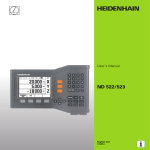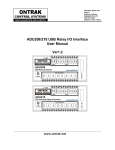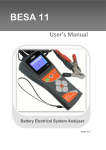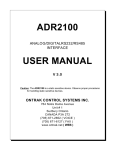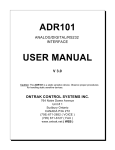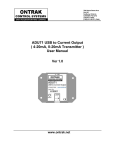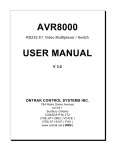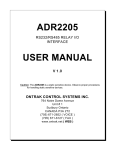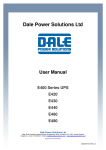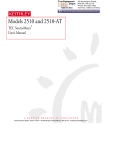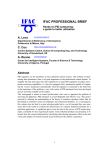Download to USER MANUAL V1.2 for ADU100
Transcript
ADU100 USB Data Acquisition Interface User Manual Ver 1.2 www.ontrak.net Ontrak Control Systems reserves the right to change product specifications to improve the product. Although every attempt has been made to ensure the accuracy of the material contained in this manual, Ontrak Control Systems assumes no liability for inadvertent errors. Warranty : This ADU100 is warranted from defects in workmanship and materials for a period of 90 days. Liability for defects is limited to the purchase price of the product. This warranty does not apply to defects resulting from improper modifications or use outside published specifications. Copyright 2003 ONTRAK CONTROL SYSTEM S INC. Page 2 of 23 ADU100 User Manual Table Of Contents 1. W hat is Included and W here to Start 4 2. ADU100 USB Data Acquisition Interface Features 4 3. Connecting the ADU100 to a USB Bus 5 4. AduHidTest USB Device Test Program 6 5. ADU100 Command Summary 11 6. ADU100 Command Descriptions 11 6a) Analog Commands 6b) Relay Commands 6c) Digital I/O Commands 6d) Event Counter Commands 6e)Special Feature Commands 11 16 17 19 20 7. The ADU100 Software Development Kit ( SDK ) 21 8. Electrical Specifications 22 Page 3 of 23 ADU100 User Manual 1. What is Included and Where to Start The ADU100 ships complete with a 10' USB cable, this User Manual and a 3.5" diskette titled ADU-SDK. The ADU-SDK diskette inlcudes the following files; AduHid.dll AduHidTest.exe AduHidHelp.chm VisualC-EG VisualBasic-EG BorlandC-EG Various support files DLL to allow applications to communicate with the ADU100 on the USB bus. Software application used to test ADU products and allow programmers to become familiar with the ADU ASCII commands. Software development kit ( SDK ) in CHM ( Windows Help File ) format. ( folder) Visual C program examples from SDK ( folder) Visual Basic program examples from SDK ( folder) Borland C program examples from SDK First time users should first review the ASCII command set for the ADU100 and then use AduHidTest to become familiar with the operation of the various features of the product. Note: The AduHid DLL requires one of the following Windows operating systems. 98SE, 2000 or XP Application programs should be written using the Software Design Kit ( SDK ) located on the ADU-SDK diskette. The SDK contains explanations of how the various communication pipes can be accessed using the AduHid DLL. Example code is given for Visual Basic, Visual C and Borland C. The SDK help file is designed to be run on the development PC when programming. This allows programmers to cut-andpaste specific functions directly into an application. Additional examples and applications are posted on our web site at www.ontrak.net 2. ADU100 USB Data Acquisition Interface -3, ISOLATED ( 3000V ) 16-Bit Analog Inputs. -Programmable PGA gives full scale input ranges from 0-19mV to +/-10V -Low noise Sigma Delta A/D -Internal self-calibration function for true 16-bit resolution -2.5000V and 5.00V reference outputs to allow direct connection of strain gauges. -High quality Aromat PA-series relay offers superior performance. -4 Digital I/O Lines -1, N. O. relay contact output rated 5.0A @ 120VAC, 5.0A @ 30VDC -Programmable watchdog functions. -Bi-colour LED status indicator. -Self-resetting, fused 5V output -Auxiliary RS232 port for connecting legacy RS232 devices. ( ADR series ) -High quality cage-clamp type terminal blocks. -Uses standard HID drivers included with Windows 98SE,2000,XP -Mini-driver ( DLL ) provided for use with VB,VC, LabVIEW and TestPoint -Programming examples and sample code included for VB, Visual C++ -Four, 16-bit event counters ( one high speed capable ) -Programmable de-bounce setting for event counters. -Bus Powered, No external power supply required. -Meets IEC61000-4-2 ESD protection for USB port. -Available in enclosure or as PCB only. Page 4 of 23 ADU100 User Manual 3. Connecting the ADU100 to a USB Bus The ADU100 can be connected to the USB bus via the enclosed 10' A-B USB cable. The cable provides both power and communications connections to the ADU100. When first connected, the STATUS led will turn RED indicating power is applied. A message will flash on the screen indicating; “New hardware Found” ADU100 USB Data Acquisition Interface Depending on the version of Windows , the host may prompt to search for a driver. Select, Let Windows Search for a Driver and click next. After a few seconds, the STATUS led will turn green indicating enumeration is complete. The enumeration process is completely transparent to the application program as it is completed by the Windows operating System The STATUS led will remain green unless a watchdog timeout ( See Special Commands Section ) occurs. The ADU100 can be connected directly to the host hub or either, external powered, or non-powered hubs. Caution: ( Use of System Standby ): If the Windows operating systems puts the system into “ Suspend ” mode, all USB hubs are issued a Reset when the Suspend mode is exited. This will cause the ADU100 to lose power briefly, resulting in the event counter data being lost and reversion to the power up state. Open the power options section in the Windows control panel and ensure “System Standby” is set to never. Caution: ( Use of PWR Terminals ): The auxiliary power connections labelled VDD and GND are a nonisolated output and no external power supply should be connected to these terminals. The power output is provided to allow use of dry contact inputs to the digital input lines. If the supply is to be used with dry contact inputs, GND should be connected to COM, and the dry contact connections made between VDD and the selected digital input line. If this power output is used for external circuits, up to 100 mA can be drawn depending on how much current is drawn from the 5.000V reference output. The total current drawn from the 5.000V reference and VDD should not exceed 100mA. Page 5 of 23 ADU100 User Manual 4. AduHidTest USB Device Test Program AduHidTest is a USB Device test program used to test the connection of ADU data acquisition devices to a USB port. The program is also a useful tool to allow programmers to become familiar with the ADU command set. The program is located in the root directory of the ADU-SDK disk. The program can be run from floppy or transferred to the hard drive. Note that the program requires the AduHid.dll to operate and it should be copied to the same directory as the AduHidTest.exe file. Getting Started: There are three steps in using a USB device in any application software. The three steps are , 1. Obtain a handle for the ADU100. 2. Send commands to the ADU100. 3. Receive data from an ADU100. STEP 1: Obtain a handle for the ADU100 A handle is a unique code that application software uses to identify a USB device for the purpose of reading and writing to the device. A USB bus can have up to 128 devices connected to a single host and there are three criteria that can be used to open a handle. The three criteria are, Vendor ID, Product ID and Serial Number. If a single device is connected to the bus, any of the three criteria may be used. If multiple devices are connected, we recommend using the Serial Number to open the handle ( All ADU devices have their unique serial number printed on the top label ) The AduHidTest program main Window is shown in Figure 1. Figure 1: AduHidTest Main Window Page 6 of 23 ADU100 User Manual The Open/Close section of the window is where the handle is determined. Click on the Show List button to view the devices connected to the USB bus. ( Note: Only ADU devices will be listed ) Figure 2 is the window that appears when the Show List Button is clicked. Figure 2: " Show List " Display The display indicates that there is an ADU100 device connected with serial number B00001. Select the device by clicking on the displayed text. The AduHidTest main window will now display the product ID and Serial number. Click the By Serial # radio button and then click Open to open the handle to the selected ADU100. Figure 3: Connected to B00001 Page 7 of 23 ADU100 User Manual STEP 2: Send Commands to the ADU100 Once connected, you may now send commands to the available "pipes" on the device. Pipes are the individual connections to functional sections of the ADU100. The Device Pipe is used to send standard ASCII ADU commands to control the peripherals built into the ADU100 such as the relay output or analog input channels. Type "sk0" ( Close relay K0 ) into the device pipe send window and click Send ADU . Relay K0 on the ADU100 will close and the software will display a small "OK" next to the Send ADU button indicating the command was sent. Figure 4: Sending "sk3" Command Page 8 of 23 ADU100 User Manual STEP 3: Receive Data from the ADU100 Some commands will cause a response to be sent from the ADU device to the host computer. For example, if an "ruc07" ( read analog channel 0 with a gain of 128 ( with calibration ) ) command is sent, the ADU100 will send back the 5 digit count. To read responsive commands, simply click the Receive ADU button and the data will be displayed. In this case, the response is 37357 indicating AN0 is at; 37357/65535 X .01953125 = 11.1334 mV. Figure 5: Sending "ruc07" and Receiving Analog Data The RS232 Pipe is used to send and receive ASCII strings to any RS232 based device connected to the ADU100 auxiliary serial port. The method of sending commands is identical to device pipe, in that you simply enter the ASCII command string, and click the Send 232 button. Data is received, and then displayed when the Receive 232 button is clicked. In the following example, an "rd" ( analog array read ) command is sent to an ADR2000B Data Acquisition Interface connected the ADU100 auxiliary serial port. Figure 6 shows the "rd" command being sent and the returned data displayed after the Receive 232 button is clicked. Note1: The RS232 pipe is designed to send and receive ASCII strings which use a CR ( 0Dh) as a termination character. AduHidTest automatically adds the CR to the string being sent. The maximum string length for both send and receive is 40 characters. The ASCII string should not contain any NULL ( 00h ) characters in both incoming and outgoing strings. Note2: The ADU100 does not support the stream pipe and so no explanation of its operation is listed in this document. Page 9 of 23 ADU100 User Manual Figure 6: Sending "rd" Command to RS232 Pipe Page 10 of 23 ADU100 User Manual 5. ADU100 Command Summary ANALOG INPUT COMMANDS RUNng RBNng Returns unipolar analog value of analog channel n using gain of g (n= 0,1 or 2, g =0 -7) Returns bipolar analog value of analog channel n using gain of g (n= 0,1 or 2, g =0 -7) RUCng Returns unipolar analog value of analog channel n using gain of g (n= 0,1 or 2, g =0 -7) ( With self-calibration ) Returns bipolar analog value of analog channel n using gain of g (n= 0,1 or 2, g = 0 - 7) ( With self-calibration ) RBCng RELAY COMMANDS ( PORT K ) SK0 RK0 RPK0 Sets relay K0 ( closes contact ) Resets relay K0 ( opens contact ) Returns status of relay K0 DIGITAL COMMANDS ( PORT A ) CPAxxxx SPAxxxx MAdd RAn SAn RPAn RPA PA P1 P0 PU Configures data direction of PORT A. ( x = 1 for input, 0 for output ) Outputs binary data to PORT A ( x =0 or 1 ) Outputs decimal data to PORT A ( ddd= 00 to 15 ) Resets I/O line, specified by n in PORT A ( n = 0,1,2 or 3 ) Sets I/O line, specified by n in PORT A ( n = 0,1,2 or 3 ) Returns status of Input specified by n ( n= 0 , 1, 2 or 3 ) Returns status of PORT A in binary format. Returns status of PORT A in decimal format. Turns on light pull-ups on PORT A Turns off light pull-ups on PORT A Returns present pull-up status ( 0 for OFF, 1 for ON ) EVENT COUNTER COMMAND SUMMARY REx RCx DBn DB Returns present count of event counter ( x = 0,1,2 3 or H ) Returns present count and clears event counter ( x = 0,1,2, 3 or H ) Sets de-bounce time of event counters ( n=0,1,2 or 3 ) ( 0 =100ms, 1 = 10ms, 2 = 1ms, 3 = 100us ) Returns present de-bounce setting. SPECIAL FEATURE COMMAND SUMMARY SBn SB WDn WD Sets baud rate of axillary RS232 port. (n = 0,1,2 or 3 ) ( 0 =9600, 1 = 19.2K, 2 =38K, 3 = 56K ) Returns present baud rate setting. Sets watchdog timeout length (n = 0,1,2 or 3 ) ( 0 =WD OFF , 1 = 1s, 2 =10s, 3 = 1min. ) Returns watchdog setting. Page 11 of 23 ADU100 User Manual 6. ADU100 Command Descriptions All commands are specified as non-terminated ASCII strings. The maximum length of command and data strings is 7 bytes. Commands are passed via the AduHid DLL to the ADU100 as a seven byte packet and unused bytes are sent as NULL ( 00h ). 6a) ANALOG INPUT COMMANDS The ADU100 features three, 16 bit analog inputs AN0, AN1 and AN2. Also featured in the analog section are two reference outputs suitable for use with external sensors such as strain gauges or potentiometers. The 2.5V REF output can source up to 10mA and the +5 VDC output can source up to 100mA. All analog inputs and reference outputs feature 3000V optical isolation from the USB bus and other I/O functions. Figure 7: Analog Connections Input Connections: Two of the inputs ( AN0 and AN1 ) are low level inputs that can be operated as two single ended inputs or used as one differential input. To operate AN0 and AN1 as two separate single-ended, unipolar inputs, LCOM MUST be shorted to AGND. Input signals are then applied to AN0 and/or AN1 with AGND used as the analog ground input. Figure 8 shows single ended voltages ( VA and VB ) connected to the analog inputs. To operate the inputs as a differential pair, + in is connected to AN1, -in is connected to LCOM and AGND is used as the analog ground input. The differential measurement is then made by simply reading the AN1 input. NOTE: in differential mode, LCOM is NOT shorted to AGND and there is no connection to AN0. An example of a differential input is shown using a strain gauge in Figure 9. The third input ( AN2) is a high level input and operates as a single ended input only. Input voltages are simply applied between AN2 and AGND. Page 12 of 23 ADU100 User Manual 6a) NOTE 1: Bipolar Input Connections to AN0 and AN1: Special considerations must be made when connecting bipolar input voltages to AN0 and/or AN1. When operating in bi-polar mode the inputs are actually pseudo-bipolar as LCOM is used as the reference for the bipolar input voltages. LCOM must not be connected to AGND and NO CONNECTION should be made to 2.5V REF, AGND, AN2 or +5VDC. Bipolar input ranges can be used with AN2 without any special considerations. Figure 9a : Bipolar Input Connections to AN0 and AN1 Page 13 of 23 ADU100 User Manual The analog channels are read individually, as either single-ended or bi-polar type inputs. An internal PGA ( programmable gain amplifier ) allows for a wide range of input voltages. Tables 1 and 2 show the available input ranges for the channels and corresponding GAIN SETTING. G AIN S E T T IN G G AIN AN 0 Input R ange AN 1 Input R ange AN 2 Input R ange 0 1 0 - 2.5V 0 - 2.5V D o N o t U se 1 2 0 - 1.25V 0 - 1.25V 0 - 10V 2 4 0 -.625V 0 -.625V 0 - 5V 3 8 0 - 0.3125V 0 - 0.3125V D o N o t U se 4 16 0 - 0.15625V 0 - 0.15625V D o N o t U se 5 32 0 - 78.125mV 0 - 78.125mV D o N o t U se 6 64 0 - 39.0625mV 0 - 39.0625mV D o N o t U se 7 128 0 - 19.53125mV 0 - 19.53125mV D o N o t U se Table 1: Available Unipolar Input Ranges G AIN S E T T IN G G AIN AN 0 Input R ange AN 1 Input R ange AN 2 Input R ange 0 1 +/- 2.5V +/- 2.5V D o N o t U se 1 2 +/- 1.25V +/- 1.25V +/- 10V 2 4 +/-.625V +/-.625V +/- 5V 3 8 +/- 0.3125V +/- 0.3125V D o N o t U se 4 16 +/- 0.15625V +/- 0.15625V D o N o t U se 5 32 +/- 78.125mV +/- 78.125mV D o N o t U se 6 64 +/- 39.0625mV +/- 39.0625mV D o N o t U se 7 128 +/- 19.53125mV +/- 19.53125mV D o N o t U se Table2: Available Bipolar Input Ranges Calibration For each analog input channel there are internal calibration registers that allow compensation for gain and zero offset errors. When an input channel is read it can be done in NORMAL or CALIBRATED mode. When the CALIBRATED mode is selected, an internal calibration is initiated before the actual reading is taken. The internal calibration switches the input of the A/D to internal references and calibrates the channel for the specified gain. Calibration registers store the coefficients to allow accurate readings using the NORMAL mode. A CALIBRATED reading takes over three times as long as a NORMAL reading as thus, CALIBRATED readings are generally only taken at the following times; 1. The first time a channel is read. 2. When a channel gain or configuration is changed. 3. When the ADU100 ambient temperature changes more than 2 degrees Celsius. Page 14 of 23 ADU100 User Manual Command Structure: The command used to read the analog channels is composed of three ASCII characters and two ASCII numbers for a total for five bytes. The first character is an “R” and is constant. The second character is either a “ U “ or “ B ” to indicate whether the measurement is to be a either a unipolar or bipolar type. The third character is either an “ N ” or “ C “ to indicate if the measurement is a normal type or one to be done with a calibration . The first number specifies the input channel to be read and is either 0, 1 or 2. The last number is the gain setting and ranges from 0 to 7. Analog Command Composition 1st Character 2nd Character 3rd Character 4th Character 5th Character R ( Constant) U for unipolar or B for bi-polar N for normal or C for calibrated Channel ID#, 0 = AN0, 1 = AN1, 2 = AN2 Gain Setting of 0 to 7 The response to all analog read commands is a 5 digit decimal number from 00000 to 65535. To convert the READING to an actual voltage, use the following formulas ; AN0 and AN1 in Single-Ended mode; Voltage = READING / 65535 X ( 2.5V / GAIN ) AN0 and AN1 in Bi-Polar mode; Voltage = READING / 65535 X ( 5V / GAIN ) - ( 2.5V / GAIN ) AN2 in Single-Ended mode; Voltage = READING / 65535 X ( 10V / GAIN ) AN2 in Bi-Polar mode; Voltage = READING / 65535 X ( 20V / GAIN ) - ( 10V /GAIN) A few examples; RUN07 34567 ( Read AN0 in unipolar mode with a gain of 128, without calibration ) ( returned data ) Voltage = READING / 65535 X ( 2.5V / GAIN ) Voltage = 34567 / 65535 X ( 2.5V / 128 ) Voltage = 10.3019mV RBN14 54690 ( Read AN1 in bi-polar mode with a gain of 16, without calibration ) ( returned data ) Page 15 of 23 ADU100 User Manual Voltage = READING / 65535 X ( 5V / GAIN ) - ( 2.5V / GAIN ) Voltage = 54690 / 65535 X ( 5V / 16 ) - ( 2.5V / 16 ) Voltage = 54690 / 65535 X ( 5V / 16 ) - ( .15625 ) Voltage = 0.10453 V RUC21 42133 ( Read AN2 in unipolar mode with a gain of 1, with calibration ) ( returned data ) Voltage = READING / 65535 X ( 10V / GAIN ) Voltage = 42133 / 65535 X ( 10V / 1 ) Voltage = 6.4290 V 6b) RELAY COMMANDS ( RELAY K0 ) There is one type A relay contact output on the ADU100 rated at 5A@120VAC or 5A at 30VDC. The relay can be SET ( closed ) or RESET ( opened ). The relay commands are; SK0 Sets ( closes ) relay contact K0 # of Bytes 3 Response NONE Example; RK0 ;closes contact K0 Resets ( opens )relay K0 # of Bytes 3 Response NONE Example; RPK0 SK0 RK0 ;opens contact K0 Returns status of relay K0 # of Bytes 4 Response 1 byte ( 0 or 1 ) Example; RPK0 1 ( response) Page 16 of 23 ADU100 User Manual ;Relay K0 is closed. 6c) DIGITAL COMMANDS ( PORT A ) PORTA is a 4 byte digital I/O port. The port can be configured in any configuration of inputs or outputs. The power up default is all inputs. Light pull-up resistors can be enabled under software control to allow the connection of external dry contact inputs. There are a multitude of commands available to read and write PORT A in both binary and decimal format. The port lines can be read or written individually, or as a 4 bit port. CPAxxxx SPAxxxx MAdd Configure data direction of PORT A ( x= 1 for input, 0 for output ) ( order is MSB-LSB ) Order is MSB-LSB and all four bits must be specified. # of Bytes Response 7 NONE Example; CPA1000 . ( PA3 is set to input, PA0, PA1 and PA2 are set as outputs ) Writes binary data to PORT A ( x= 1 for HIGH, 0 for LOW) Order is MSB-LSB and all four bits must be specified. Individual lines configured as inputs are not affected by this command. # of Bytes Response 7 NONE Example; SPA1110 . ( PA3, PA2, and PA1 are set HIGH, and PA0 is reset to LOW ) Writes decimal data ( dd ) to PORT A ( dd = 0 to 15 ) Individual lines configured as input are not affected by this command. # of Bytes Response 3 or 4 NONE Example; MA15 ( All lines of PORT A are set HIGH ) Page 17 of 23 ADU100 User Manual RAn Resets I/O line specified by n ( n= 0 , 1, 2 or 3 ) # of Bytes 3 Response NONE Example; SAn Sets I/O line specified by n ( n= 0 , 1, 2 or 3 ) # of Bytes 3 Response NONE Example; RPAn RPA2 1 ( response) ;PA2 is High. Returns status of PORT A in binary format. # of Bytes 3 Response 4 bytes ( 0000 tp 1111 binary ) Example; PA SA1 ( PA1is set to HIGH ) Returns status of I/O line specified by n ( n= 0 , 1, 2 or 3 ) # of Bytes 4 Response 1 byte ( 0 or 1 ) Example; RPA RA2 ( PA2 is reset to LOW ) RPA 0100 ( response) ;PA2 is High, PA0,PA1 and PA3 are Low Returns status of PORT A in decimal format. # of Bytes 2 Response 2 bytes ( 00 to 15 in decimal ) Example; PA 15 ( response) ;All lines are High.. P1 Enables light pull-ups on I/O all lines configured as inputs. # of Bytes 2 Response NONE P0 Disables light pull-ups on I/O all lines configured as inputs. ( DEFAULT SETTING ) # of Bytes 2 Response NONE PU Returns status of light pull-ups. # of Bytes 2 Response 1 Byte ( 0 if disabled, 1 if enabled ) Page 18 of 23 ADU100 User Manual An example of dry contact connections using the internal pull-ups is shown in figure 12. Figure 12: Dry contact Connections Note that when using the internal pull-ups, the inputs read a logic 1 or HIGH when the contact input is OPEN or there is nothing connected to the input. Dry contact inputs are then connected between GND and the associated input and return a logic 0 or LOW when the contact is closed. 6d) EVENT COUNTER COMMANDS Each digital input line on PORTA has an event counter associated with it. The event counters count low to high transitions and store them in a 16 bit counter that can be read or, read and cleared. The event counters are numbered 0 to 3 and count from 00000 to 65535 followed by a rollover to 00000. The debounce time of the event counters can be set from 100us to 10ms. Additionally, PA0 has a high speed event counter ( H ) that is not affected by the de-bounce setting. Event counter H has a maximum input frequency of 250KHz. REx Returns present count of event counter ( x = 0,1,2 3 or H ) # of Bytes 3 Response 5 bytes ( 00000 to 65535 in decimal ) Example; RCx RE1 00023 ( response) ;PA1 has seen 23 Low to High Transitions Returns present count and clears event counter ( x = 0,1,2, 3 or H ) # of Bytes 3 Response 5 bytes ( 00000 to 65535 in decimal ) Example; RC3 00156 ( response) ;PA3 has seen 156 Low to High Transitions ; ( Event Counter 3 is cleared ) Page 19 of 23 ADU100 User Manual DBn Sets de-bounce time of event counters ( n=0,1 or 2 ) ( 0 =100us, 1 = 1ms ( Default ) , 2 = 10ms ) # of Bytes 3 Response NONE Example; DB DB0 ;De-bounce is set to 100us Returns present de-bounce setting. # of Bytes 2 Response 1 bytes ( 0,1, or 2 ) Example; DB 0 ( response) ;De-bounce is set to 100us 6e) SPECIAL FEATURE COMMANDS The ADU100 has several special features including a host watchdog timer and an auxiliary serial ( RS232 ) port. The following commands are used to implement these features. The RS232 port has a programmable baud rate from 9600 to 56K. This setting determines the BAUD rate used for both transmit and receive. This parameter should be set before RS232 transmission or reception commences. SBn Sets baud rate of auxiliary RS232 port. (n = 0,1, 2 or 3 ) ( 0 =9600 ( Default ) , 1 = 19.2K, 2 =38K, 3 = 56K ) # of Bytes 3 Response NONE Example; SB SB3 ;Sets Baud rate to 56K Returns present baud rate setting. # of Bytes 2 Response 1 bytes ( 0,1, 2 or 3 ) Example; SB 0 ( response) ;Baud Rate is 9600 A programmable host watchdog is provided to allow predicted operation in the event the host PC stops communicating with the ADU200. Upon timeout, the relay K0 is RESET, WD =0, and the status indicator will turn from GREEN to RED. Any command sent to either the DEVICE or RS232 pipe will reset the watchdog timer. To determine if a watchdog timeout has occurred, read the timer setting. If the watchdog was set to 2, and no command was sent for 10 seconds, a 0 will be returned indicating a timeout has occurred. Following a timeout, the host must reload the timer setting as a timeout causes the setting to be set to 0 ( WD OFF ) WDn Sets watchdog timeout length (n = 0, 1, 2 or 3 ) ( 0 =WD OFF ( DEFAULT ) , 1 = 1s, 2 =10s, 3 = 1min. ) # of Bytes 3 Response NONE Example; WD2 ;Sets WD timeout to 10s Page 20 of 23 ADU100 User Manual WD Returns watchdog setting. # of Bytes 2 Response 1 bytes ( 0,1,2 or 3 ) Example; WD 0 ( response) ;Watchdog not enabled or timeout has occurred. 7. The ADU100 Software Development Kit (SDK) Application programs must use the AduHid DLL provided to send commands and receive data from the ADU100. This is done using simple API calls from the application language AduHid DLL location The SDK is located on the ADU-SDK diskette and includes explanations of how the pipes to the various ADU100 features operate. The SDK contains examples for use with Visual Basic, Visual C and Borland C. Additional programming tutorials and applications are located at www.ontrak.net Page 21 of 23 ADU100 User Manual Electrical Specifications S upply V o ltage N O N E ( B us P o wered ) S upply C urrent 180mA T ypical, 200mA M aximun O perating T emperature 0 - 50 C Low -Lev el Analog Inputs ( 2 ) R eso lutio n 16 B its T ype 2 S ingle E nded o r 1 Differential R anges ( P ro grammable ) 0-2.5 , 0-1.25V , 0-.625V, 0-.3125V , 0-156.25mV , 0- 78.125mV , 0- 39.0625mV , 019.53125m V 1. +/-2.5V , +/-1.25V , +/-.625V +/-.3125V , +/-156.25mV +/-78.125mV , +/-39.0625mV +/19.53125m V Input Z 100K M in. C o mm o n M o de R ange +/- 5 V D C Iso latio n 3000V Linearity 0.0003% T ypical O ffset E rro r equal to no ise level when calibrated G ain E rro r equal to no ise level when calibrated N o ise ( peak to peak ) 4.7uV ( GA IN =1 ) 0.63uV ( GA IN = 128 ) S ample R ate 50 s/s (S ingle C hannel) H igh-Lev el Analog Input (1) R eso lutio n 16 B its T ype S ingle E nded R anges ( P ro gram mable ) 0-5V D C, 0-10V D C +/-5V D C, +/-10V D C Input Z 27K M in. C o mm o n M o de R ange -11 to + 12 V D C Iso latio n 3000V A C Linearity 0.0003% T ypical O ffset E rro r +/- 10mV M ax G ain E rro r 0.2% max T ypically 0.05 % Page 22 of 23 ADU100 User Manual N o ise ( peak to peak ) 35uV M ax. ( 10V R ange ) 20uV M ax. (5V R ange ) S ample R ate 50 s/s (S ingle C hannel) R elay Output ( 1) T ype A C Ratings 5 A M P S @ 120V A C D C R atings 5 A M P S @ 30V D C D igital I/O (4) ( T T L) V in H IG H ( M A X ) 5 VDC V in H IG H ( M IN ) 2 VDC V in LO W ( M A X ) 0.7V D C V in LO W ( M IN ) 0 VDC R eference Outputs ( 2 ) O utput 1 2.500VD C +/- 0.5mV O utput 2 5.00V D C +/- 2.5mV 10mA M ax 100mA M ax. S pecial Functions R S 232 P o rt M o unting Optio ns A uxiliary R S 232 po rt allo ws co nnectio n to A S C II based serial interfaces. P ro grammable baud rate fro m 9600 to 56K . D eskT o p, Velcro , Panel ( P C B Only ), DIN R ail Page 23 of 23 ADU100 User Manual























